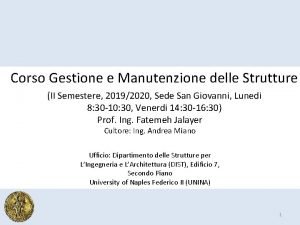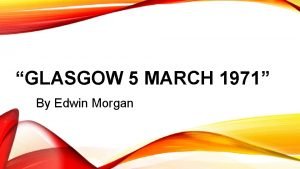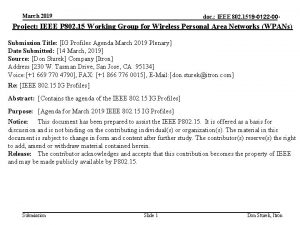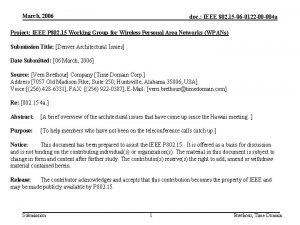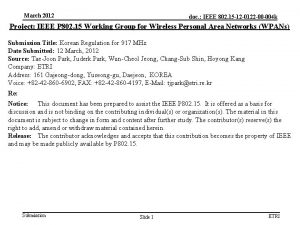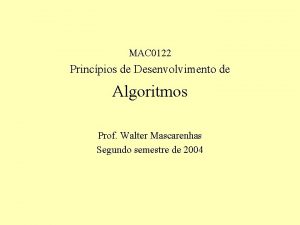March 2018 doc IEEE 15 18 0122 01





- Slides: 5

March 2018 doc. : IEEE 15 -18 -0122 -01 -0 vat Project: IEEE P 802. 15 Working Group for Wireless Personal Area Networks (WPANs) Submission Title: Water Vehicle Emergency Warning Signal Application using Li. Fi/CAMCOM Technology Date Submitted: March 2018 Source: Jaesang Cha (SNUST), Minwoo Lee (SNUST), Jeong Gon Kim (Korea Polytechnic Univ. ), Hyeongho Lee (Netvision Telecom Inc. , Korea), Mariappan Vinayagam (SNUST) Address: Contact Information: +82 -2 -970 -6431, FAX: +82 -2 -970 -6123, E-Mail: chajs@seoultech. ac. kr Re: Abstract: This documents introduce the V 2 V Li. Fi/Cam. Com Link design consideration for VAT. This proposed Li. Fi/Cam. Com for water vehicle used for emergency warning signal. This VAT to operate on the application services like ITS, ADAS, Io. T/Io. L, etc. on road condition. Also this can be used for LEDIT, Digital Signage with connected information services etc. Purpose: To provided concept models of Light Communication based Li. Fi/Cam. Com solution for Vehicular Assistant Technology (VAT) Interest Group Notice: This document has been prepared to assist the IEEE P 802. 15. It is offered as a basis for discussion and is not binding on the contributing individual(s) or organization(s). The material in this document is subject to change in form and content after further study. The contributor(s) reserve(s) the right to add, amend or withdraw material contained herein. Release: The contributor acknowledges and accepts that this contribution becomes the property of IEEE and may be made publicly available by P 802. 15. Submission Slide 1 Jaesang Cha, SNUST

March 2018 doc. : IEEE 15 -18 -0122 -01 -0 vat Contents • Needs for Water Vehicle Emergency Warning Signal • Li. Fi/Cam. Com Technology for Water Vehicle • Conclusion Submission Slide 2 Jaesang Cha, SNUST

March 2018 doc. : IEEE 15 -18 -0122 -01 -0 vat Needs for Water Vehicle Emergency Warning Signal • Emergency Warning ˗ Casualties to large navigational buoys, primary lights or lightships. ˗ Changes in depth of water ˗ Dangerous wrecks or obstruction to navigation ˗ Floating dangers-like containers, drifting buoys, icebergs ˗ Newly established aids to navigation ˗ Gunnery or fire exercise areas and underwater activities in certain areas ˗ Vessels aground in approaching port areas ˗ Any changes or development of new buoyage system ˗ Gale warnings < Water Vehicles In Use Scenario > GOOGLE • Basic Concept ˗ Uses the Lighting System and the PD/Camera connected on water vehicle to enable Li. Fi/Cam. Com technology for communication between water vehicles Submission Slide 3 Jaesang Cha, SNUST

March 2018 doc. : IEEE 15 -18 -0122 -01 -0 vat Li. Fi/CAMCOM Technology for Water Vehicle • Light Based Li. Fi/Cam. Com Link on Water Vehicles ˗ Tx : Water Vehicle Lights ˗ Rx : PD / CCTV Camera ˗ Day-Night Communication Mode ˗ Modulations : § < Water Vehicle Li. Fi Cam. Com Link > • • PPM, Inverted PPM, Subcarrier PPM, Uses the Li. Fi/Cam. Com Technology to communicate between water DSSS SIK etc. vehicles for emergency condition information broadcasting, Water vehicle ˗ Data Rate : 1 K ~ 1 Mb/s specific secured informations, etc. ˗ Supported Lo. S (Line of Sight) Helps to protect the water vehicles from emergency situation locks and ˗ Available Distance : more than 500 m saves human / goods, etc. • OOK, VPPM, Offset-VPWM, Multilevel Use the existing lighting infrasture and on vehicle cameras for with lens Li. Fi/Cam. Com Link Submission Slide 4 Jaesang Cha, SNUST

March 2018 doc. : IEEE 15 -18 -0122 -01 -0 vat Conclusion • Proposed the Water Vehicle Emergency Warning Signaling method using Li. Fi/CAMCOM Technology • Uses the existing infrastructure to built the system and does not required any additional infrastructure needs to be Installed • Provides warning signals to nearby water vehicles casualties to large navigational buoys, primary lights or lightships, Changes in depth of water, Dangerous wrecks or obstruction to navigation, floating dangers-like containers, drifting buoys, icebergs, etc. • Reduce the travelers/goods risk and avoids confusions on the way of sailing. Submission Slide 5 Jaesang Cha, SNUST




